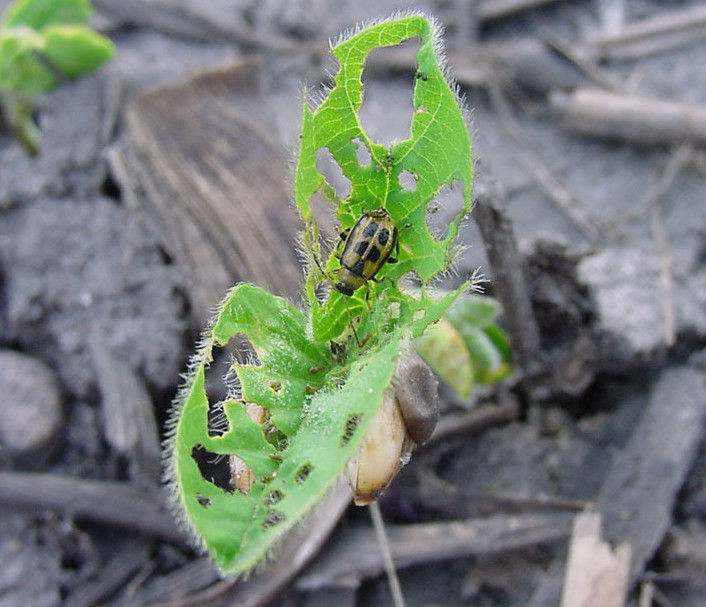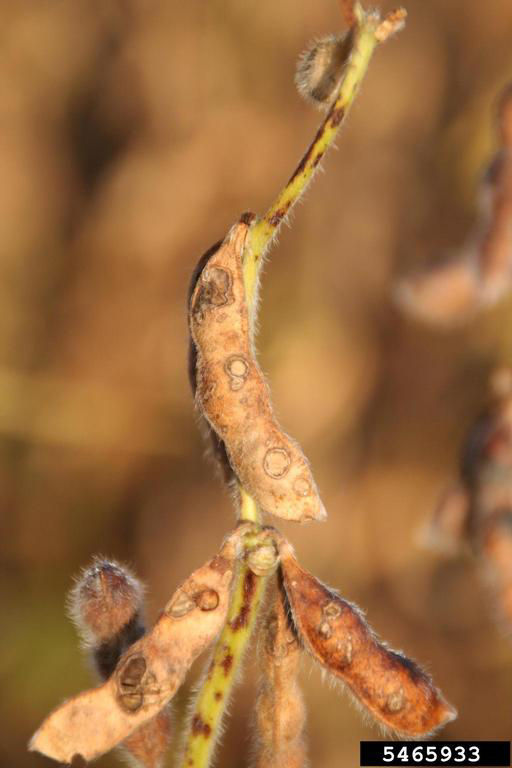Bean Leaf Beetle Management in Late Season Soybean
June 24, 2021
The summer generation of the bean leaf beetle can feed on soybean pods resulting in a reduction of bean quality and yield potential. In addition to direct feeding by the adult, the beetle can transmit bean pod mottle virus. Bean pod mottle virus can reduce both yield potential and bean quality as well as cause green stem syndrome, delaying harvest.
Identification
The adults are about ¼-inch long and usually yellow, tan, or red in color. The beetle always has a black triangular mark on its wing covers directly behind the thorax (Figure 1). Often two black spots are present on each wing cover and a distinct black band extends around the outer edges. Occasionally, the wing covers have no markings, except for the black triangle. When disturbed, the bean leaf beetle falls to the ground and feigns death.

Injury and Management
While early season feeding result in in loss of leaf tissue, in most cases the injury is not economically important; however, pod feeding can result the economic injury that affects both quality and yield potential (Figure 2). As the foliage matures and is less attractive to beetles, they feed on the green, immature tissue of pods, resulting in a thin “window-pane” membrane over the seed. As the pod matures, this membrane often cracks exposing the seed to airborne plant pathogens. The pathogens may cause discolored, moldy, shriveled, and/or diseased beans resulting in a loss of quality.

Soybean fields should be scouted for late season pod feeding by bean leaf beetle. The injury by bean leaf beetle adults will result in the “window-pane” injury, and seldom does the injury extend into the seed. Other pod feeding insects, like grasshoppers, will extend the feeding to include the seed.
Randomly select 2 plants in each of 5 areas of the field, a total of 10 plants.
Count the number of pods per plant and the number of pods that are injured.
Calculate the percentage of damaged pods per plant for the field as a whole while determining the maturity stage of the pods (green, beginning to turn yellow, or are yellow/brown).
Using a sweep net take 5 sets of 20 sweeps per field (100 sweeps) to determine the number of beetles while observing if the adults are actively feeding.
Calculate the number of bean leaf beetles per sweep.
Use table below to base treatment decisions.
| Number of beetles per sweep in 30-inch rows or (7-inch rows)* | |||
| Pod Injury - Percentage | If < 4 or (<3) adults | If 4 (3) to 7 (5) adults | If > 7 (>5) adults |
| 0 to 8% | Quit sampling | Sample again in 5 days |
Apply control if pods still green |
| 8 to 12% | Sample again in 5 days |
Apply control if pods still green |
Apply control if pods are green to yellow |
| Over 12% | Apply control if pods still green |
Apply control unless pods are completely dry |
Apply control unless pods are completely dry |
From Krupke, C. and Obermeyer, J. 2020. Bean leaf beetle pod feeding on late maturing soybean. Purdue University Extension. bean-leaf-beetle-pod-feeding-on-late-maturing-soybean/ |
|||
Management Options
There are numerous foliar insecticides to select from if treatment is needed. When applying a late summer treatment for prevention of further pod feeding, farmers should be aware of pre-harvest intervals for many of the insecticides, which can range from 14 days to 60 days. The time left before anticipated harvest of a field may dictate the insecticide chosen.
Sources:
1 Krupke, C. and Obermeyer, J. 2020. Bean leaf beetle pod feeding on late maturing soybean. Purdue University Extension. https://extension.entm.purdue.edu/newsletters/pestandcrop/article/bean-leaf-beetle-pod-feeding-on-late-maturing-soybean/
2 Holshouser, D. 2009. Green stem syndrome in soybeans. Virginia Cooperative Extension. 2912-1430. http://www.ext.vt.edu.
6018_S1